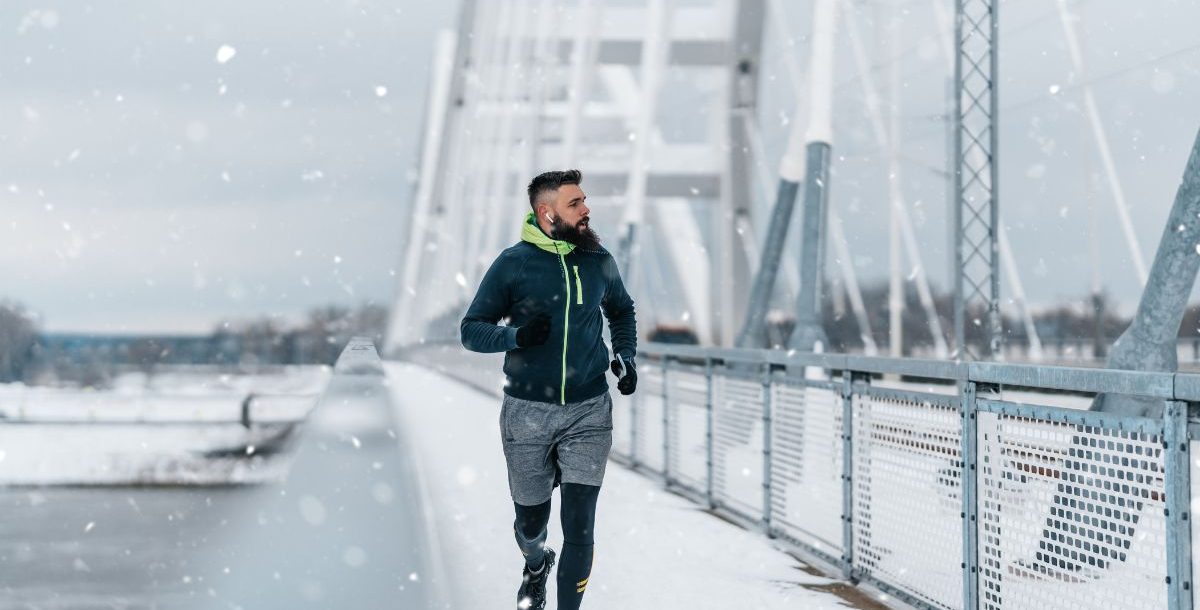Running in cold weather can be invigorating and rewarding, but it also requires the right gear to stay warm, safe and comfortable. Proper clothing enhances performance and helps prevent hypothermia, frostbite and other cold-related health issues. Here’s a guide to the best clothes to run in cold weather.
Why choosing clothes to run in cold weather is important
Cold temperatures can cause the body to lose heat rapidly, especially through the head, hands and feet. Inadequate clothing can lead to frostbite or hypothermia, particularly when temperatures dip below freezing. That’s why choosing the right clothes to run in cold weather is essential.
Essential cold weather running gear
It can be difficult to strike the right balance when choosing your clothes to run in cold weather. You should feel slightly chilly when you start, and if you sweat excessively early in the run, you are likely overdressed.
The three-layer rule
Wearing the right layers can help regulate your body temperature, wick moisture and protect you from harsh winds and precipitation. The three-layer rule is the first step in dressing for a run in the cold.
Base layer: Moisture-wicking fabrics
Start with a base layer made of moisture-wicking material like polyester or merino wool. These fabrics pull sweat away from your skin, keeping you dry and reducing the risk of chills. Avoid cotton, as it retains moisture and can make you feel colder.
Mid-layer: Insulation
An insulating layer traps heat to keep you warm. Options include long-sleeved shirts made of fleece or synthetic materials designed for cold weather. Choose a thickness appropriate for the temperature – opt for lightweight insulation for milder cold and thicker layers for freezing conditions.
Outer layer: Weather protection
A windproof and water-resistant running jacket protects against the elements. Look for breathable materials that prevent overheating while shielding you from wind and rain. Reflective details are also essential for visibility during shorter daylight hours.
Other cold-weather items to consider
Legwear: Insulated running pants or tights
Thermal running tights or pants are a must for keeping your legs warm. Compression tights with fleece lining provide insulation while promoting blood circulation.
Accessories: Protect your extremities
Exercise causes your body to reroute blood flow toward your core. As it moves away from your ears, hands and feet, those body parts are the first to get cold. You’re more likely to develop frostbite if you don’t protect them as the temperatures drop.
- Headgear: Wear a thermal beanie or headband to prevent heat loss through your head and keep your ears warm.
- Gloves: Insulated running gloves are essential to keep your fingers warm. For extreme cold, consider mittens or glove liners.
- Socks: Opt for wool or synthetic running socks that wick moisture and provide insulation.
Footwear: Weather-resistant shoes
Cold-weather running shoes with waterproof uppers and good traction are crucial. Pair them with gaiters to keep snow and moisture out.
Extras: Buffs and hand warmers
- A neck gaiter or buff can protect your face and neck from icy winds.
- Hand warmers are a good option for particularly cold runs.
- Running vests are an extra layer that can add additional warmth.
Tips on dressing for cold weather runs
- Layer strategically: Layering allows you to adjust your clothing as needed. Start slightly cool – your body will warm up as you run.
- Monitor the weather: Check the temperature, wind chill and precipitation forecast before heading out. Adjust your clothing accordingly.
- Prioritize visibility: With shorter days, wear reflective gear and consider a headlamp or LED armband for visibility.
- Avoid overdressing: Overdressing can lead to excessive sweating, which makes you feel colder. Dress as if it’s 10 to 20 degrees warmer than the actual temperature.
- Know when to change: If your clothes get wet during a run, head indoors to change into dry, warm clothing immediately. Wet or damp clothes can increase heat loss.
Health benefits of running in cold weather
Running in cold weather has its advantages, including improved cardiovascular endurance and mental resilience. However, avoid running outside if temperatures or wind chills are dangerously low. Also, listen to your body. Stop running and seek shelter if you experience numbness, tingling or signs of frostbite.
How we can help
Winter running can be safe and enjoyable with the right gear. Invest in high-quality base layers, insulated clothing and protective outerwear to stay warm and comfortable. By dressing appropriately and taking precautions, you can maintain your running routine throughout the winter months.
However, accidents happen. If you get injured on a run or get sick, make an appointment with a provider or visit an urgent care near you.
Learn about the orthopedics and sports medicine services we offer at Bon Secours.





